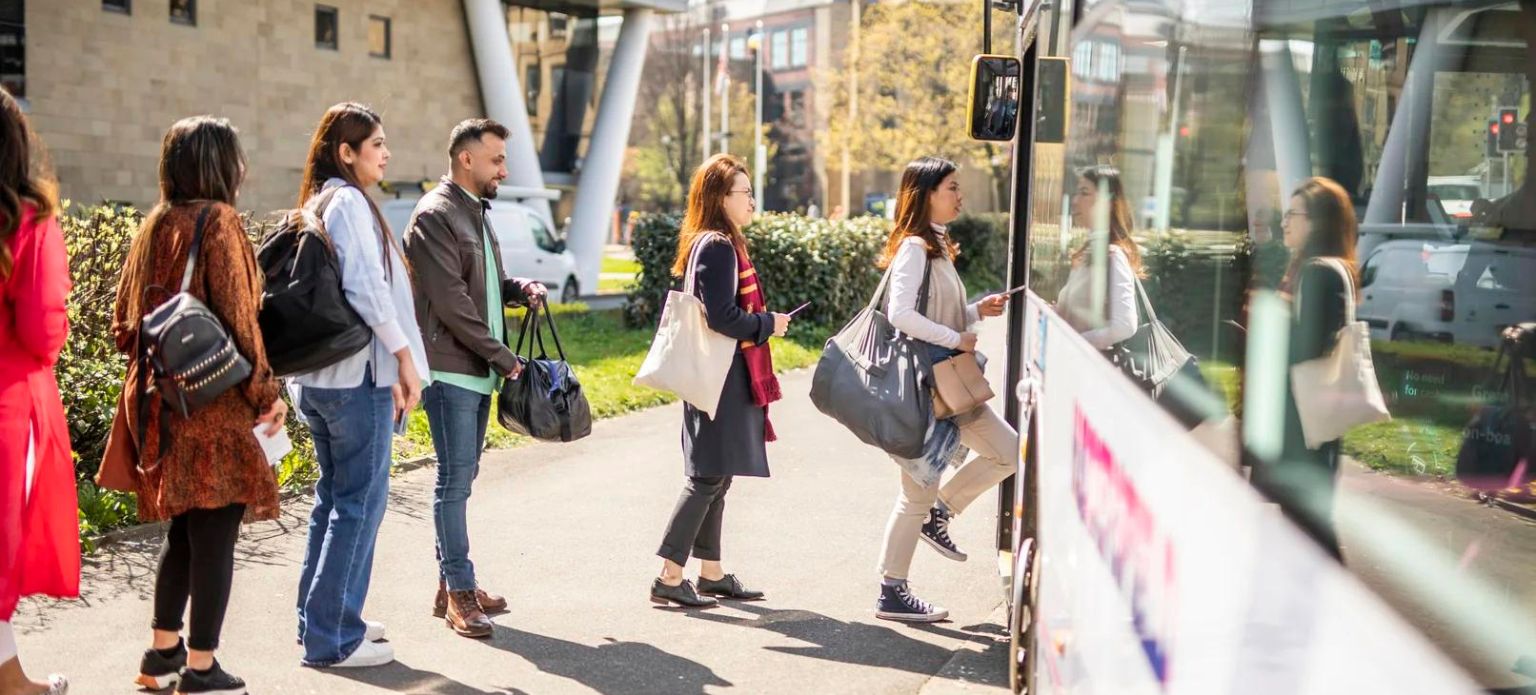
UK Public Transport for International Students: A Guide
- Categories All Study in Abroad Blogs, Study in the UK, Studying Abroad
- Date April 17, 2024
The public transportation system in the UK contributes to the lives of its 67.85 million population. Kinda makes you picture Mumbai Locals, doesn’t it? Yet somehow, it is not like that. When 2,342 trains in Mumbai carry more than 7.5 million commuters on any given day, the UK facilitates numerous options to divide the crowd. Cities, the countryside and everywhere in between are connected with public transportation. Apart from the national transportation services, cities also have their own transport systems and regulations. Navigating through the ticketing, timing and other processes could seem daunting at first, but international students easily find themselves sitting pretty.
The UK has calibrated several aspects of its living to enable students’ comfort. UK travel experiences are tops the list. Students can take public transportation to classes, part-time jobs, city tours and so much more, all under a budget. Their step-free access, audio-visual announcements and dedicated spaces for wheelchairs make them accessible to everyone. Additionally, they are also making sustainable efforts to reduce emissions and EV replacements.
Flight
The UK has a total of 144 airports with flights starting only at INR 10,000. In fact, London and Birmingham are the cheapest airports in the UK. It is easy to travel between provinces and cities. Students can fly from London to Manchester in only an hour! Further, there are 24 international airports to travel beyond the border.
Trains
An extensive train network connects cities and towns throughout the UK. The National Rail makes it possible to get around almost everywhere. While some cities have well-developed systems, some are waiting for investments to turn their way. The National Rail includes Intercity Trains, Regional Trains and Commuter Trainers to cater to distinguished requirements. Students aged between 16-30 can travel with their railcards to save as much as 1/3rd on travel costs. Advance and group bookings fruit with discounts too. Notably, bookings can only be made online, at the station or via a travel agent. Further, Eurostar offers high-speed continent trains between the UK, Paris, Lille, Calais, Brussels and Amsterdam.
The London Underground
Travellers in the London Underground often referred to it as the Tube. Oh, Jack, that is in fact what they call it here. The Tube has been the most iconic transport in the UK since 1863. All major cities including London, Glasgow, Liverpool and Tyne and Wear benefit from this fast hustle-free urban transport. During the peak hours, it is rushing with commuters and tourists. Once could see all sorts of people on the tube – musicians, businessmen, tourists and so on.
The tariffs vary as per the hour and route. Applications like Citymapper and TFL’s Journey Planner help navigate through the routes as well as the train schedules. Students can get a pre-paid ticket or a contactless Oyster card to save money. Weekly, monthly or annual options are available with almost 30% discount. The cost of an Oyster card is £24.57. Furthermore, this card can also be linked to their Railcard to their Oyster Card offline to receive more discounts.
London Buses
The London buses would remind you of the iconic double-deckers in India. Offered in most cities throughout the day, students can commute with London buses within the city using their travel card, debit card or offline tickets. For regular journeys, this is one of the most common and cost-effective options. Citymapper helps find the best routes. For longer routes, the UK has coaches. Students can book tickets and get a Coachcard from National Express. Cities also have their own coach providers. For instance, Scotland has Citylink whereas Northern Ireland has Translink. Students can travel around the mainland with Eurolines, Flix Bus and National Express.
Trams and Light Rails
Found in only some cities, Trams are a cheerful site. Above that, they have a flat fare of £1.75. Going at the maximum speed of 50 miles per hour, students can breathe in the beauty of the UK. Romantising studying abroad is incomplete without riding in one of these. However, at a busy hour, they are only convenient to travel short distances. They accept Oyster cards too.
Taxis
Speaking of great views! Remember seeing the marvellous, shiny and luxurious cabs on a Netflix series based in London? Black Cabs are yet another iconic form of transport in London. And yes, they don’t come cheap. Students can use Uber, Bolt or ViaVan instead. Taxis are easily accessible in all cities and towns. But before you hop into one, ensure they are safe and licensed. Univerisities could also help suggest Cabs or Drivers.
River Bus
Travelling with ferries is a great way to beat the traffic while still capturing the views of London. It’s fairly popular in the coastal areas and islands. With routes operated by MBNA Thames Clippers, ferries range in size to carry passengers as well as vehicles. Students can pay for this service with Oyster Cards and contactless cards.
Cycling and Bike Sharing
Undoubtedly, the cheapest mode there is in the UK. Students use bicycles to ride around the city. However, in the bustling streets of London, it is not so convenient to get around on a cycle. With confidence and caution, students can rent bicycles to ride as they need. It is often said that if you have driven in India, you can drive anywhere. When in the UK, stay clear of car doors opening quickly, claim your space on the road and avoid the blind spots of the vehicle ahead of you. Cities also have facilities like bike lanes, bike-sharing, bike renting schemes, etc.
Driving
Students aged 17 years or above can get a driving license in the UK. For students in the UK for a shorter course, they can drive with their Indian license for up to 1 year, and not more. Along with a registered and taxed car, students also need to get insurance. The UK is strict about older cars and has an MOT test to check if it is road-worthy.
Planning your Journey
Before choosing a mode of transportation in the UK, let’s evaluate your journey to come to an informed decision. After defining a starting point and destination, identify the mode of transportation system closest to the points. There is simply no point in taking half an hour’s bus to only walk another half. Research routes with online journey planners like Transport for London, Traveline or Translink. There are also local websites and transport apps to do the same. Pick the most suitable mode based on duration, expense and weather. Get a relevant travel card to book your tickets considering the time you need to leave and reach coupled with buffer time.
Etiquette is a matter of everywhere. If you think about it, they are quite practice too. For instance, keep your ticket/pass and money in the most convenient pocket, ensure that your personal items are compact and away from the aisle, and follow the rules. A big part of the UK’s travel etiquette is respecting others by maintaining the queue and offering seats to those who need them more. It is more a concern of humanity than travelling efficiently.
With awareness of the surroundings and oneself, students can efficiently enjoy their travels in and around the UK. Venturing into the scenic beauties, they can choose from the available transportation options.
Have a query? Connect with Studywise International today!
You may also like

Ireland Intake 2024-25: Universities & Preparation Timeline

TOEFL Scoring System and Validity


